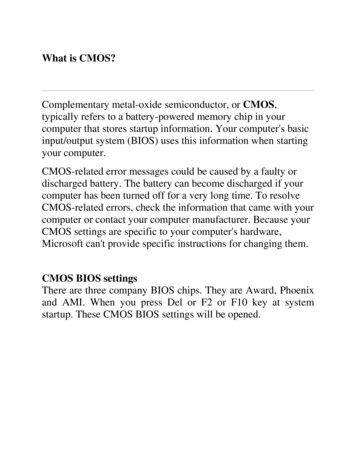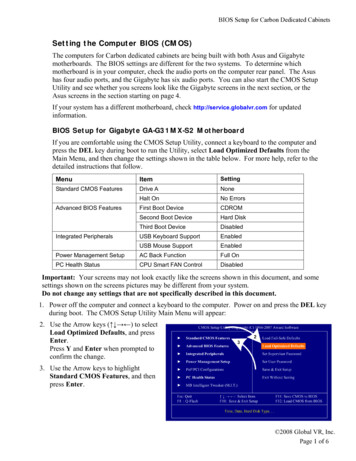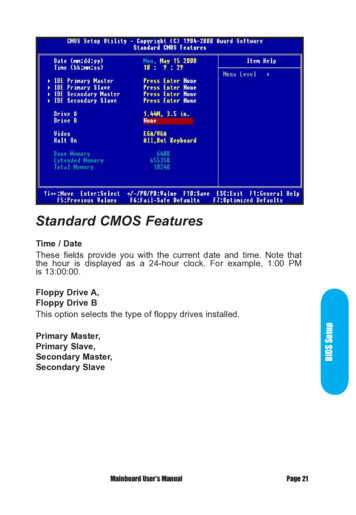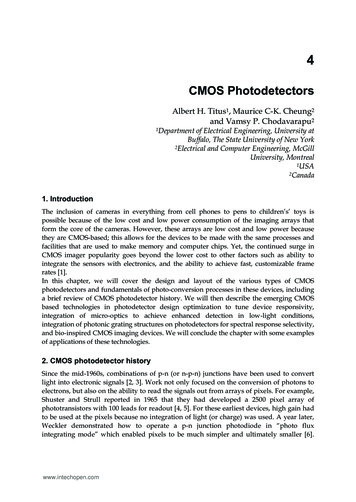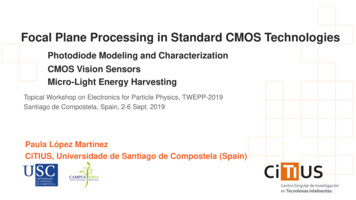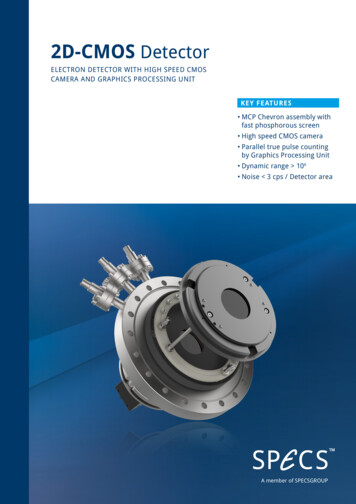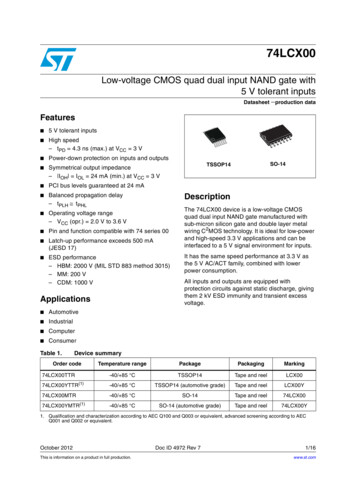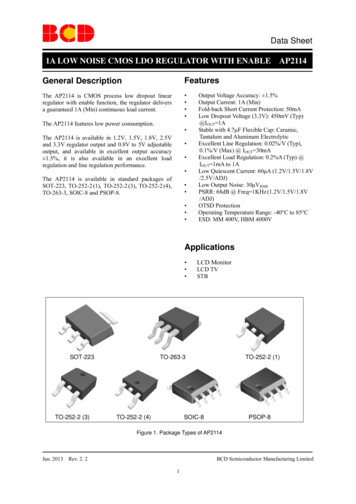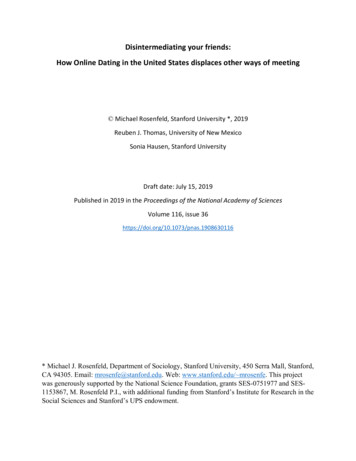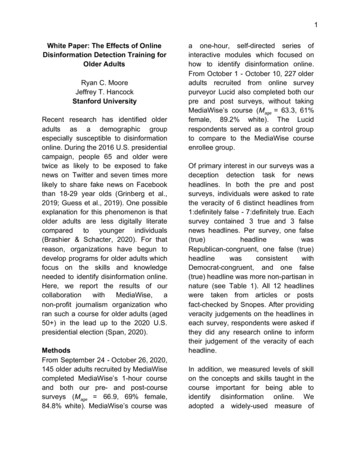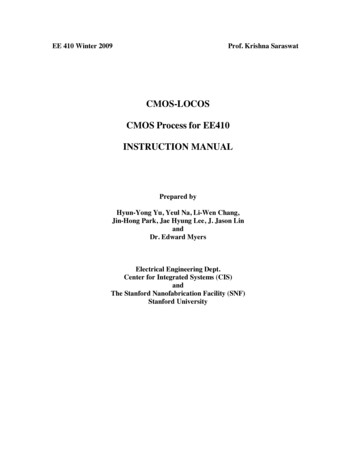
Transcription
EE 410 Winter 2009Prof. Krishna SaraswatCMOS-LOCOSCMOS Process for EE410INSTRUCTION MANUALPrepared byHyun-Yong Yu, Yeul Na, Li-Wen Chang,Jin-Hong Park, Jae Hyung Lee, J. Jason LinandDr. Edward MyersElectrical Engineering Dept.Center for Integrated Systems (CIS)andThe Stanford Nanofabrication Facility (SNF)Stanford University
EE 410CMOS LOCOS Student ManualTABLE OF CONTENTS12INTRODUCTION . 3LABORATORY SAFETY . 32.1Safety Philosophy . 32.2General Safety. 43BACKGROUND . 54SUMMARY OF CMOS-LOCOS . 64.1General Features . 64.2Comparison to Typical CMOS Processes. 74.3Modifications from CIS/CMOS to CIS/CMOS-II. 74.4Modifications from CIS/CMOS-II to CMOS-LOCOS. 75PHOTOLITHOGRAPHY. 85.1Description of Mask Levels . 85.2Mask Alignment Patterns. 95.3Mask Alignment Errors . 95.4Lithography Procedures . 106PROCESSING TECHNIQUES . 106.1Laboratory Safety. 106.2Clean-Room Techniques. 106.3Wafer Cleaning Techniques. 117PROCESS FLOW. 117.1Global Alignment Marks and Blanket Substrate-Implantation . 117.2Field Oxidation and Active Region Definition. 127.3P-Well Formation and Kooi Oxidation. 127.4Gate Oxidation . 137.5Polysilicon Gate Formation . 137.6Source/Drain Implantations . 147.7Low Temperature Glass (LTO) Deposition. 147.8LTO Densification and Silicon Anneal. 147.9Contact Hole Formation and Metallization. 147.10 Final Passivation for Packaging (Optional) . 158SIMULATIONS . 178.1Process Simulations . 188.2Device Simulations . 198.3Circuit Simulations (Optional). 199TEST STRUCTURES AND MEASUREMENT METHODOLOGY . 199.1Fabrication Test Structures . 209.2Process Test Structures . 209.3Device Test Structures . 239.4Circuit Test Structures . 279.5SEM Test Structures (Optional) . 2810REFERENCES . 2811APPENDIX A: LIST OF CMOS-LOCOS STRUCTURES. 2912APPENDIX B: Pad Assignments . 35Page 2 of 2Revision Date: Jan. 2010
EE 4101CMOS LOCOS Student ManualINTRODUCTIONThe purpose of this document is to serve as a guide for EE410, the Integrated CircuitLaboratory Course taught at Stanford University. The subject of this course is thesimulation, fabrication and testing of a simplified, 0.45µm gate length CMOS processdeveloped for EE410 and for use as underlying circuitry for device research. EE410 ishighly recommended for students planning to conduct research in the Class 100 cleanroom Stanford Nanofabrication Facility (SNF) at the Center for Integrated Systems (CIS)or how seek a career in device fabrication. To be admitted into the class, students mustbe familiar with IC processing at the level of EE212 and fundamental device physics atthe level of EE216, and must have the consent of the instructor.CMOS-LOCOS is designed so that in one academic quarter, students have theopportunity to fabricate complete CMOS IC wafers using the SNF facility and in theprocess, learn the practical skills, laboratory techniques and safely in wafer fabricationand testing. The nominal gate length of CMOS-LOCOS is 0.5µm. While commerciallyavailable gate lengths are much shorter, this dimension is compatible with standard SNFprocessing and provides a solid teaching device platform. At the end of the process run,students will have fabricated functional 0.45µm MOS transistors, inverters, and ringoscillators along with a variety of process test structures.The CMOS-LOCOS design is an introductory framework for conventionalsemiconductor processing. Students are encouraged to probe further into the principlesand operating details of the equipment, methodology and device physics. It is thecommand of such topics that will distinguish successful contributors in your chosencareer. Through courses like EE410, graduate research projects in the SNF lab, andcontinuous seminars presented by leading experts from industry and other researchinstitutions, it is possible for Stanford students to emerge with a level of expertise whichis difficult to acquire even at the most advanced corporate research labs. Thus, it iscritically important for the students to grasp all of the available learning opportunitiespresented on campus. Students need to think on their own, to go beyond the scope of thismanual and to challenge, improve or amplify some aspect of CMOS-LOCOS, as wasdone previously with the former CIS/CMOS and CIS/CMOS-II processes. It is expectthat the CMOS-LOCOS will continue to evolve in coming years through to the interestand insight of students.2LABORATORY SAFETY2.1 Safety PhilosophyThe current safety policies are provided on the SNF web site. The following informationis provided only as an introduction to the safety information and should not be consideredcomplete or definitive. It is the responsibility of all Lab Members to be skilled, up todate and practice all safety policies and procedures.The primary goal of the SNF safety program is to prevent accidents. This can be achievedif each and every person in the lab observes appropriate safety precautions. However, itis understood that no system is perfect, and accidents can happen. The second goal of thePage 3 of 3Revision Date: Jan. 2010
EE 410CMOS LOCOS Student Manualsafety program is also to minimize the effect of an accident by educating lab members onhow to respond in emergency situations.SNF Staff ResponsibilityThe responsibility of SNF with regard to laboratory safety is to: educate and inform lab members of the potential safety hazards and appropriateresponse procedures; and provide the appropriate tools and resources to use the lab safely.The tools and resources provided by the SNF staff to lab members includes (but are notlimited to): the MSDS sheets which are provided near the SNF Stockroom; operatingprocedures and training in safe operation for each tool; personal protective gearappropriate for laboratory processing and training in its use; documented and postedprocedures for actions to take in an emergency situation; knowledgeable personnel,trained in safety and emergency procedures.Lab Member ResponsibilityYour responsibility, as an SNF lab member, is to behave in a safe, conscientious, andprofessional manner in all lab activities. The SNF provides you with information andtools to use the lab safely; however, it is incumbent upon each individual to takeresponsibility for his/her own personal safety. Moreover, as the SNF is also a community,each lab member is responsible for the safety of his/her fellow lab members. At thediscretion of the SNF staff anyone found behaving irresponsibly to the extent ofendangering others may be immediately removed and denied future access to the lab.It is also your responsibility to report any safety concerns you may have to any SNF staffmember. An alternative is to report any potentially unsafe conditions or practices, or tooffer suggestions for improving safety to safety@snf.stanford.edu.2.2 General SafetyLab Behavior As in any area where chemicals are in us, eating and gum chewing is prohibited.Drinking is prohibited in the lab, except at the water dispenser located in theservice area. Individual water bottles are prohibited in the lab. Avoid sudden or fast movements. Running or fast walking is not permitted.Approach corners and turns slowly to avoid collisions with others. Alwaysremember that lab members around you may be handling sensitive or hazardousmaterials, such as chemicals, or their year's worth of work. Always clean up after yourself -- remove or store everything that you havebrought into the lab with you. Label all personal belongings with your name. Always be aware of your work area and be sensitive to what other lab membersare doing around you.Clothing Shoes worn in the lab must fully enclose the feet. No sandals, open toe, highheels or sling-back shoes are allowed.Page 4 of 4Revision Date: Jan. 2010
EE 410 CMOS LOCOS Student ManualYou will be wearing a bunnysuit over your normal clothing. We recommend yourclothes be light, comfortable and allow free movement. Bare legs (i.e., wearingshorts and dresses) are not recommended; slacks are preferred as they provideadditional protection.Eye Protection Safety glasses are required at all times in the lab. Safety glasses should be of typeB, C, D, G, or H (with side shields or other side protection) and conform to ANSIstandard (marked "Z87".) Lab members requiring corrective lenses, impactresistant prescription safety glasses with side shields may be purchased from mostprescription glasses suppliers. Most safety glasses are designed to protect against flying fragments, and notchemical splash hazards. Full face shields are worn, in addition to glasses whenhandling chemicals or working at chemical wet benches. SNF abides by the American Chemical Society recommendation that "contactlenses can be worn in most work environments provided the same approved eyeprotection is worn as required of other workers in the area." (C&E News, Vol. 76,p. 6.) Thus, contact lens wearers need to wear standard safety glasses whenworking in the lab, and full face shields in addition to safety glasses whenworking at chemical wet benches.Personal Protective Gear While operating certain stations, additional protective wear will be required. Useof any wet benches or the normal handling or transportation of any chemicals inthe lab requires the use of personal protective chemical wear.Buddy System For safety reasons, a lab member is not allowed to work in the lab alone at anytime. Because the lab runs 24/7, there may be occasions (such as a late night,early in the morning, over a long holiday weekend) when there are no otherpeople working in the lab. If you plan to work during a time when the lab mightbe expected to be empty, you must plan ahead and coordinate your work schedulewith another lab member. This way, you can be sure to have a buddy and canwork safely.3BACKGROUNDDuring the summer and fall of 2008 a major redesign of the EE410 device structures andteaching mask set was completed. The redesign was coupled to SNF obtaining theASML 5500/60 stepper. Using this stepper platform, it became routine to print 0.5 µmfeature sizes. In order to keep the process robust, a 1 µm minimum, nominal feature sizewas chosen.The major design change introduced with this design revision was to move away fromwet etched, thick field oxide for isolation to LOCOS isolation. The LOCOS added moresteps early in the process flow, but it provides a more traditional isolation withoutmoving to even more complex shallow trench isolation (STI) The redesign followed aPage 5 of 5Revision Date: Jan. 2010
EE 410CMOS LOCOS Student Manualground up approach. Each device design starts with a parameterized Cadence p-cell.This allows for a rapid, scalable change in device dimensions and the ability to layoutcustom designs using the standard device library to meet future research needs. Thedevice library was designed as a 8 mask
2008, Jae Hyung Lee, J. Jason Lin developed CMOS-LOCOS 1993, Alvin L.S. Loke developed CIS/CMOS-II 1987, Robert Scheer developed CIS/CMOS 4 SUMMARY OF CMOS-LOCOS 4.1 General Features The CMOS-LOCOS process is characterized by the following: EE410 class uses 7 mask levels (including the ASML global mark exposure)
